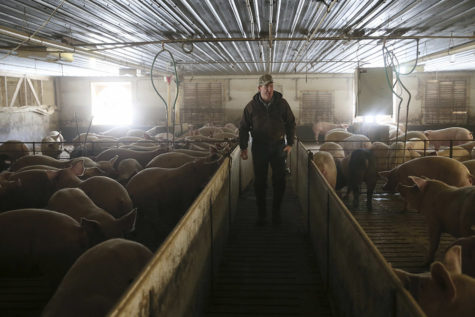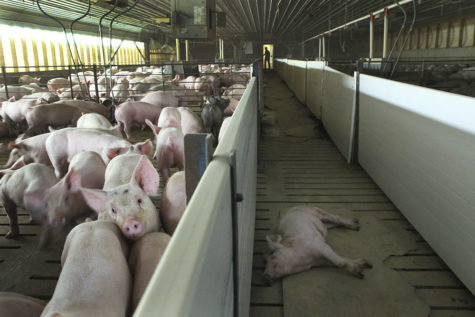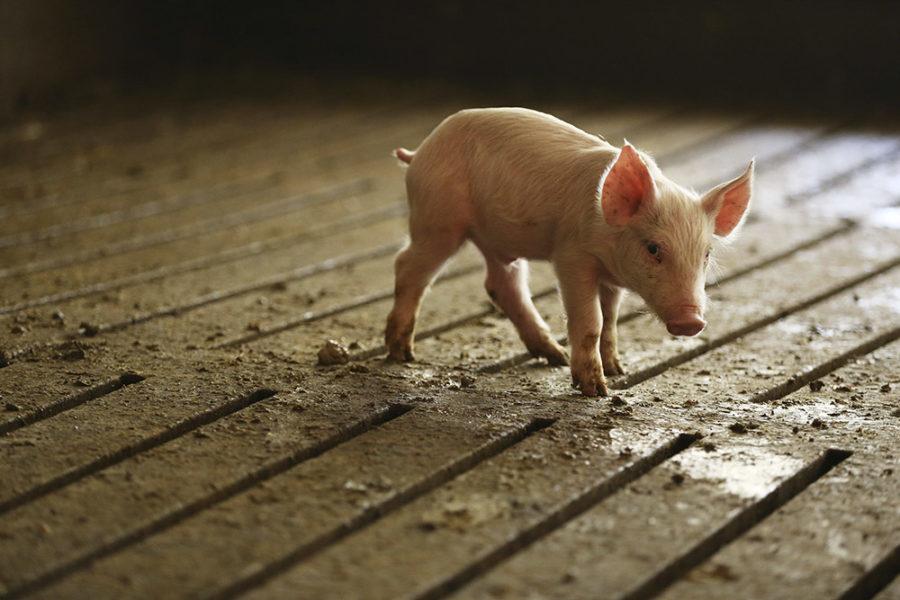Editorial: ‘The price of pork’ in Illinois: Poisoned creeks yet limited regulation
A young pig in a hog confinement operation walks across a slotted floor. The movement of pigs across their pen pushes their waste through the slots into a storage pit below. (Stacey Wescott/Chicago Tribune/TNS)
August 17, 2016
If you’ve ever been to a pig farm, or near one, you won’t forget the aroma. No, not the smell of frying bacon — the foul, ammonia-laced stench of hog waste.
The U.S. produces $21 billion of pork a year, including $6 billion for export. Illinois is the fourth-largest producing state, behind Iowa, North Carolina and Minnesota.
That’s a lot of pigs raised for slaughter downstate. And a lot of manure.
Advertisement
The swine business is unavoidably filthy, but it shouldn’t be poisonous to the state’s waterways.
A Tribune series, “The Price of Pork,” details how the muck and yuck of pigs represent an under-regulated pollution threat.
When farmers raising thousands of pigs mismanage their waste storage systems, harmful effluents can leach into creeks and rivers. In some cases, farmers overwhelmed with the stuff recklessly dump excess manure into streams or over-fertilize fields with it, creating a runoff risk.

The four-part Tribune report, by David Jackson and Gary Marx, examines the industry from snout to tail. Anyone whose relationship with pork is limited to supermarket shopping and backyard grilling should read it to understand where their packages of brats and chops come from.
Industrial pig farming helps feed the country and provides jobs, but sometimes at an unanticipated cost: There are issues with the humane treatment of animals as well as the waste products.
As the series explains, the state’s pork business is concentrated on 484 massive farms, known as hog confinements. They raise more than 5,000 pigs at a time and account for much of the state’s estimated $1.5 billion in annual sales.
The system is about as efficient as it can get: Pigs spend their entire lives in these massive shed-like facilities. Automated machines dispense food and water.
Advertisement*
And after the pigs have digested their food? In a typical design, the pigs stand on a slotted concrete floor that allows waste to fall below into an eight-foot-deep storage pit.
That waste is then transferred via pipes to a storage lagoon, where it eventually becomes fertilizer to be spread on fields … to grow the crops to feed more pigs. It’s a virtuous cycle when the system works properly.
When things go wrong, it creates an environmental hazard. Pipes can break and lagoons can overflow, allowing pig waste to escape into rural waterways.

Leaks and spills destroyed hundreds of thousands of fish in 67 miles of Illinois waterways over a 10-year span, the series reports: “No other industry came close to causing that amount of damage.”
While the series documents fewer than 80 of these events among 900-plus swine facilities during the past decade, they shouldn’t happen at all. When they do, operators should know they will face quick, significant sanctions.
But that’s where the breakdown occurs, the series reports: Illinois has weak oversight. The state Department of Agriculture, which is responsible for promoting livestock production and regulating it, has little authority to deny permit applications for hog confinements, the series says.
When the big farms have spills, they typically pay small fines.
Even keeping track of these farms is problematic: Unlike other large pork states, Illinois protects the privacy of producers.
There is no public database of hog confinements, which prevents local residents from determining how many are in their area.
Contrast Illinois with Iowa, for example, which operates a confinement database. Minnesota, which publishes addresses on websites, has a strong system of county and state approvals, Danielle Diamond of Illinois Citizens for Clean Air & Water tells us.
These seem like logical fixes for Illinois. The more regulatory authority there is in place, and more visible it is, the more likely farmers and business owners will be to act responsibly.
Illinois needs agriculture jobs and exports, and should find ways to encourage pork production, now a global industry. But that growth shouldn’t leave a stench.
___
(c) 2016 the Chicago Tribune
Visit the Chicago Tribune at www.chicagotribune.com
Distributed by Tribune Content Agency, LLC.
Advertisement







